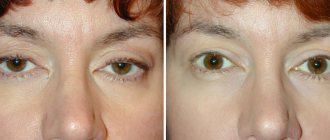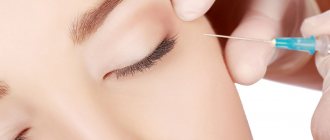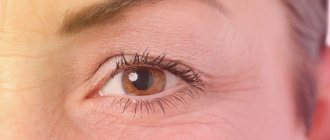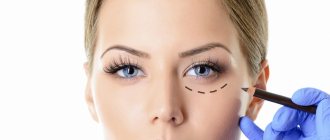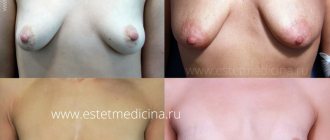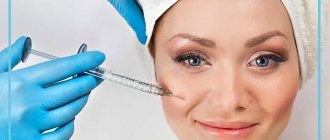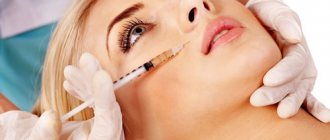What does it look like?
The drooping of the eyebrows after the injection looks like an influx of skin onto the ciliated edge, resulting in the formation of folds. Also, the eyelid may become filled with swelling and swelling of the skin . This is especially noticeable when it appears asymmetrically; in addition, bags can form under the eyes. Swelling and redness may occur at the injection site.
Photo
And here’s what drooping eyebrows look like in the photo.
Recommendations for prolonging the lifting effect
Rules that will help prolong the lifting effect on the eyebrow area:
Stay in a vertical position after the injection for at least five hours, do not bend over (pressure will lead to disturbances in the lifting area).- For three days, actively work at the injection site (blink and wink more often, develop facial expressions). Being active will help tone your muscles and allow Botox to take effect better.
- Avoid contact with the treatment area for about a day - constant touching will cause the product to spread over the entire eyelid.
- It is forbidden to visit a sauna, bathhouse or solarium for two weeks (high temperatures will ruin the lifting effect and lead to swelling.
- For two weeks, refrain from physical activity and going to the gym.
- It is forbidden to consume alcohol and antibiotics for two weeks, so as not to cause rejection.
We invite you to read the articles about the Botox procedure for eyebrows:
- Injections into the forehead and between the eyebrows.
- Raising eyebrows.
When does the feeling of drooping eyelid go away?
@rsamouresthetic
Despite its popularity, the procedure can lead to unpleasant complications. One of them is drooping of the upper eyelid. This side effect is common. You need to familiarize yourself in advance with the possible reasons why it may drop.
This situation arises due to a decrease in muscle tone, then the eyebrow may also droop and the face becomes asymmetrical. Swelling of the tissues, forehead, and eyelids occurs. Paralyzed fibers cannot provide blood flow. As a result, soft tissue can pull the upper eyelids down.
Treatment in such cases varies significantly. Sometimes the effects go away on their own, but you may need help from a doctor. Without his recommendations, there is no need to use different drugs.
There are various factors that influence the development of drooping eyelid:
- The body's reaction to the drug. The more injections were performed, the higher the risk of developing consequences in the form of ptosis. This situation usually happens after using Botox for several years without a break.
- Increased dosage. In this case, prolapse occurs as a result of incorrect dilution of the drug or incorrectly selected puncture sites. An overdose leads to drooping of the eyelid line and eyebrows. It is recommended to use injections with a small dose of the drug; if the effect is insignificant, repeat the procedure.
- Incorrect distribution in tissue. After puncture, the molecules of the substance spread over a certain distance. There is a risk of damage to neighboring muscles that did not need to be relaxed.
The problem is visible visually. The eyelid changes its natural position and moves downward. Ptosis is usually visible a few days after the injections. It may be noticeable in one or both eyes. It can be partial, incomplete or complete.
@dr_barinova
The process leads to facial asymmetry. Eyes with ptosis are poorly hydrated, which can lead to irritation. There may be difficulty closing the eyes, and the eyelids feel heavy. Due to tilting the head back to improve vision, the neck muscles are overstrained and blood flow is disrupted.
It is possible to eliminate ptosis in such a situation. Usually the eyelid returns to its correct position in less than a month. In more severe cases, symptoms disappear only after 6 months. To restore muscles, an additional dose may be administered to correct asymmetry.
Medicines are used and procedures are done to restore muscle function. Surgical methods to get rid of the problem are almost never used. To avoid negative consequences, it is recommended to contact only qualified doctors.
Reasons why this happens
Why do eyebrows droop after the procedure? The reasons may be different, they manifest themselves in many areas :
- Initially, what causes eyebrow drooping is the unprofessionalism of the cosmetologist. A Botox injection affects the muscle, and it relaxes, and wrinkles should smooth out. It is important to correctly calculate the injection site. Inaccuracy in its choice causes unpleasant consequences.
- At the same time, professionals may experience similar reactions. Every body is unique, and cosmetic surgery can hit a nerve, causing prolapse.
- The individual reaction of the body - muscle tone can lead to this effect, since the drug will be poorly absorbed. Or frequent punctures (usually after the fourth procedure) lead to an overabundance. The muscles simply won’t have time to recover.
- Large dosage - injections in more quantities than necessary leads to negative effects. This is calculated by unscrupulous cosmetologists; the patient comes to correct another area in order to straighten out the face.
- Point administration. It is carried out by inexperienced cosmetologists without taking into account the anatomical features of the patient.
- Distribution of Botox - If the muscles have a large diffusion area (penetration), then several types of facial muscles may be affected, resulting in lowering of the eyebrow and its swelling.
Who is to blame for the occurrence of ptosis after Botox?
Of course, all responsibility for the quality of the procedure lies with the specialist. But it’s not always a matter of his lack of professionalism. The following factors can lead to the appearance of the conditions described above:
- Individual intolerance to the administered drug. It occurs especially often if Botox (Dysport) is administered frequently. However, after the first procedures everything is usually fine. The “critical mass” of the drug is achieved in 8-10 sessions, which are performed over a period of approximately 3-4 years. Between procedures you need to take breaks, during which time muscle mobility will be completely restored. If, after the next procedure, cosmetologists notice that the forehead, eyelids or eyebrows have “dropped”, the amount of the drug is reduced and the area of its administration is narrowed.
- High dosage of the drug. In this case, the occurrence of ptosis after Botox is caused by careless injections or the use of large amounts of botulinum toxin. There are many options for administering the drug, and all of them have the right to life, however, increasing the amount of the substance increases the risk of complications. +
- Some inexperienced cosmetologists often administer drugs according to a universal scheme. One of the most dangerous points used for Botox injection is located 1 cm from the inner edge of the eyebrow. Each person's eyebrows are positioned differently, sometimes they are at the level of the edge of the eye socket. Therefore, if these features are not taken into account, Botox often “turns off” the frontalis muscle or some part of the eye muscle.
- Features of injection distribution: after an injection, the drug molecules “move” slightly further from the injection points. The likelihood of upper eyelid muscle paralysis depends on diffusion: the higher it is, the greater the risks. All drugs have their own distance - this fact must be taken into account by the cosmetologist.
Consequences
The first thing that catches your eye is facial asymmetry .
The eyeball is poorly moisturized and cleaned, which leads to frequent blinking and chronic irritation; the patient also experiences difficulty controlling the muscles of the eyebrows and eyelids - this is accompanied by a constant feeling of eye fatigue, heaviness of the eyelids and headaches. Paralysis of a certain area of the eyes causes disturbances in blood circulation and the outflow of tear fluid, and the patient experiences constant lacrimation. A drooping eyebrow blocks vision, which can lead to vision problems.
Treatment options
There are many ways to fix a problem. They are used depending on the severity of ptosis. Home methods are available to everyone and do not require large expenses. However, you will have to wait longer for the result than in other cases. Physiotherapy and various injections are usually prescribed in combination to more effectively and quickly solve the problem. If they fail, then in extreme cases doctors recommend resorting to surgery.
Home methods
To make the drooping of the eyebrows go faster, you need warmth. You can act locally - applying a hot compress to the eyebrow, while covering the forehead area. Or you can go to the bathhouse or sauna and steam yourself properly. But with the warming method, caution is in order. If ptosis is caused by swelling, then this can worsen the problem, and the swelling will descend to the area of the bridge of the nose and cheekbones.
Self-massage helps a lot. It must be done daily. The following organic oils are well suited for these purposes:
- shi;
- coconut;
- jojoba;
- shea butter
Gently treat the injection area, moving strictly along the massage lines.
Medications
Injections of drugs such as:
- "Neuromidin";
- "Prozerin";
- "Neuromultivitis".
Apraclonidine eye drops can cause muscle spasm, thereby lifting it. In the complex treatment of ptosis, mesotherapy cocktails are also used to saturate the tissues with vitamins - with their help, recovery occurs faster.
Additional injections
For minor problems, doctors sometimes prescribe repeated Botox injections. They are made into fibers that lower the eyelid, balancing the strength of the antagonist muscles. The second option is to inject the toxin around the other eye so that the eyebrow above it also droops slightly.
As a result, symmetry will appear and ptosis will not be so noticeable.
Physiotherapy
In case of damage to the oculomotor nerve, physiotherapeutic methods are resorted to. The following procedures are assigned to correct the problem:
- ultra-high frequency therapy;
- paraffin therapy;
- laser;
- electrophoresis;
- galvanic currents.
❤
How to prevent upper eyelid ptosis
No one can be immune from ptosis of the upper eyelid after a beauty injection. However, you can reduce this risk by following simple rules:
- You should only contact specialists who have been working with botulinum toxin for many years. This will minimize the number of errors associated with technique and dosage, and if a complication occurs, it can be quickly and safely eliminated.
- If minor neurological symptoms occur, the procedure should not be performed: due to overstrain, the muscles may react in an unpredictable way.
- Follow all recommendations for facial care after Botox injection: many of them are aimed specifically at preventing drooping eyelids.
What needs to be done when eyelid ptosis does appear after Botox? Contact another specialist with extensive experience, tell him in detail about the drooping eyelid and the procedure. Then he will use a different dosage of the drug and will be more attentive during the work process.
Sources
- https://BorodaDeda.ru/voprosy-i-otvety/posle-botoksa-opustilis-brovi/
- https://beautyexpert.pro/kosmetologiya/inektsionnaya/botoks/dlya-brovej/opushhenie-b.html
- https://brovee.ru/uhod-i-lechenie/opushhenie-brovej-posle-botoksa/
- https://www.ochkov.net/wiki/ptoz-verhnego-veka-kak-oslozhnenie-posle-botoksa.htm
- https://zamzy.tv/kosmetolog/botulinum/botoks-opustilis-brovi.html
